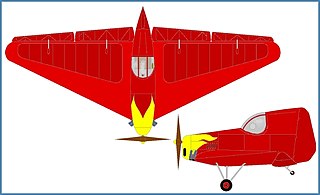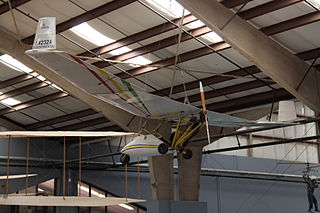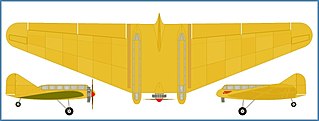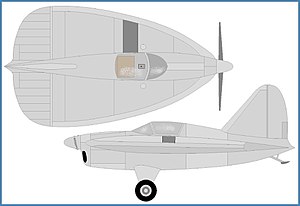
The BICh-20 Pionyer was a tailless research aircraft designed and built in the USSR from 1937.
The Yakovlev UT-3, initially known as the AIR-17 and then Ya-17, was a twin-engine low-wing monoplane aircraft designed by Alexander Sergeyevich Yakovlev for the Soviet Air Force (VVS).

The Alpaero Choucas is a French two seat, single engine tailless kit-built ultralight motor glider. At least 12 are flying, with more under construction.
The Farman F.1020 was an experimental aircraft built in France in 1933 to investigate the behaviour of a semi-circular wing fitted with unconventional controls. It had a short career and only one was constructed.
The Moskalyev SAM-14 was a late 1930s Soviet, five-passenger transport, one of a series of developments of the successful Moskalyev SAM-5.
The Moskalyev SAM-25 was an early 1940s Soviet, military assault transport, the last of a series of developments of the successful Moskalyev SAM-5.

The Marske Monarch is a single-seat, high-wing, strut-braced, tailless ultralight glider and motor glider that was offered both as plans and a kit for amateur construction by Marske Aircraft.

The Mitchell Wing B-10 is an American high-wing, open cockpit, single-seat, tailless, ultralight aircraft and motor glider designed by Don Mitchell and based on his Mitchell Wing hang-glider. It has been produced by a variety of companies in the form of kits and plans for amateur construction. It first flew in 1980.
The Chasle LMC-1 Sprintair is an all-metal, single-seat sports light aircraft designed in France in the early 1970s and intended to be built by aero clubs from plans.

The Payen Arbalète was a small, pusher configuration, experimental French tailless aircraft, designed by Nicolas Roland Payen, and first flown in 1965.
The Renault 6P, also called the Renault Bengali, was a series of air-cooled 6-cylinder inverted in-line aero engines designed and built in France from the late 1920s, which produced from 130 kW (180 hp) to 200 kW (270 hp).

The RRG Storch V was the only member of Alexander Lippisch's Storch series of tailless aircraft to be powered. It flew successfully in the year 1929.

The Moskalyev SAM-13 was a prototype twin-engined single-seat low-wing fighter built in the Soviet Union in the 1930s.

The Kharkiv KhAI-3 or Aviavnito-3 was one of several Soviet mid-1930s motor glider transports intended to reduce transport costs.

The Kharkiv KhAI-4 was an experimental Soviet tailless aircraft tested in 1934. It only made three flights before being grounded as dangerous.
The RRG Delta I was a German experimental tailless aircraft flown in the early 1930s first as a glider and then powered. It was one of the first delta wing aircraft.

The Moskalyev SAM-6 was an experimental design intended to test the suitability of monowheel undercarriages, lighter than conventional gear, on tailless aircraft.

The Moskalyev SAM-7 Sigma was a one-off, Soviet, experimental tailless fighter aircraft.
The Moskalyev SAM-10 was a late 1930s Soviet light transport aircraft suited to passenger or ambulance roles. Despite proving outstanding in trials, engine supply curtailed its production.
The Moskalyev SAM-11 was an amphibious version of the SAM-5bis-2, with a flying boat hull, retractable landing gear and raised engine and tail to avoid spray. Only one was built.











